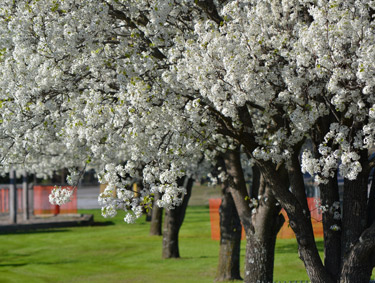Think Twice Before Planting: The Invasive Callery (Bradford) Pear
Searcy, Ark. –

It may look pretty in bloom, but don’t be fooled—its blossoms stink, and so does its invasive ways!
The callery pear (Pryus calleryana) is a medium-sized tree that was introduced to the U.S. from Asia in the early 1900s in an attempt to fight the fire blight of the common pear. The callery (or Bradford) pear has a full, dense and pyramidal growth form with smooth gray bark. Its showy white flowers with five petals appear in early spring before the leaves emerge. The glossy leaves turn dark red in the fall and the tree produces small green to brown fruit.
It has commonly been used as an ornamental due to its’ showy white flowers in early spring and beautiful fall foliage. This rapidly growing tree provides shade around homes and commercial property and birds consume the fruit. There are both thorned and thornless cultivars. The Bradford pear or Chanticleer pear are common cultivars that show resistance to disease and pests and tolerate a range of environmental conditions.
Why You Shouldn’t Plant Callery (Bradford) Pear Trees
First of all, callery pear are weak trees that are prone to wind and ice damage.
The seeds of callery pear and its various cultivars are easily dispersed by birds, allowing it to invade open spaces such as pastures, grassland and open woodlands. Its rapid growth quickly fills in these open spaces, converting them to woodlands.
What makes them invasive?
They threaten native species and ecosystems.
It's ability to form dense thickets results in the shading out of native species, causing a rapid change in plant and wildlife communities. This tree is a significant threat to native grasslands and grassland wildlife, but also invades forested areas.
Due to its dense structure, callery pear is an excellent roosting tree for gregarious blackbirds, grackles and starlings, which are problematic in urban areas due to defecation on cars and sidewalks and human health concerns. Callery pear is a weak tree and is easily damaged by ice and wind, commonly resulting in utility outages. Callery pear flowers also produce an unpleasant smell of rotting fish.
Callery pear can also rapidly transform productive agricultural land into dense woodland.
How to Control Callery Pear Effectively
Zero tolerance for callery pear is recommended. Since it resprouts vigorously, complete removal is challenging, often requiring herbicides. Mowing is ineffective due to resprouting.
The best time to apply herbicides is in late summer or early fall. Newly established trees can be controlled using foliar herbicides like triclopyr. For trees less than 6 inches in diameter, basal bark treatment works well. Spray from the base of the stem (at ground level) up to 12 inches with a mixture of 25% triclopyr ester (approximately 60% active ingredient) and 75% crop oil. Fully coat the entire circumference of the stem.
When trees are cut down, the cut stump method can be highly effective. Apply a solution of 25% triclopyr ester or undiluted glyphosate to the entire cambium within 15 minutes of cutting. Follow-up treatments may be necessary, as saplings can produce seeds as early as three years of age.
What are some good alternatives?
There are many trees that make good alternatives to callery pear in Arkansas.
Plants that are commercially available, beautiful AND noninvasive:
- eastern redbud (Cercis canadensis)
- American plum (Prunus americana)
- Mexican plum (Prunus mexicana)
- Carolina buckthorn (Frangula caroliniana)
What can you do?
- Remove all callery pears from your property and be vigilant in controlling new seedlings.
- If you see callery pear for sale, discuss the issue with the nursery owner.
- Talk to city representatives about controlling callery pear on city property and programs to discourage invasive plants within the city.
- Discuss invasive plants with your homeowner’s association and suggest removing them from common areas.
By Sherri Sanders
County Extension Agent - Agriculture
The Cooperative Extension Service
U of A System Division of Agriculture
Media Contact: Sherri Sanders
County Extension Agent - Agriculture
U of A Division of Agriculture
Cooperative Extension Service
2400 Old Searcy Landing Road Searcy AR 72143
(501) 268-5394
ssanders@uada.edu
The Arkansas Cooperative Extension Service is an equal opportunity institution. If
you require a reasonable accommodation to participate or need materials in another
format, please contact your County Extension office (or other appropriate office)
as soon as possible. Dial 711 for Arkansas Relay.
Pursuant to 7 CFR § 15.3, the University of Arkansas System Division of Agriculture
offers all its Extension and Research programs and services (including employment)
without regard to race, color, sex, national origin, religion, age, disability, marital
or veteran status, genetic information, sexual preference, pregnancy or any other
legally protected status, and is an equal opportunity institution.